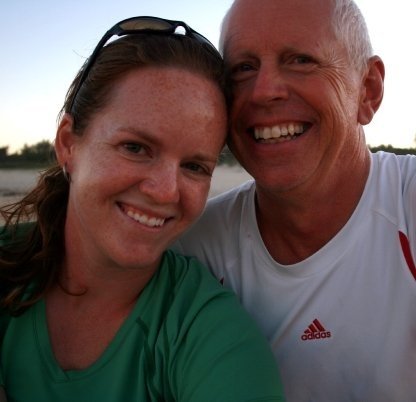Yongala Dive has a spiffy little boat that they take people out to the wreck on, which is only a 30 minute ride from Alva Beach compared to three hours each way from Townsville. Getting to the dive site proved to be half the fun, as we were driven to the beach in a 4x4 and then skidded and roared our way down the beach in the sand. The boat was hauled to the beach by a big John Deere tractor, which we piled into before it was backed into the surf. A couple waves crashed over the stern, where we were sitting, soaking us before we were even afloat! Once we got past the surf zone, it was a pretty smooth ride since the boat was able to plough right through most of the swells. We actually lucked out with the weather, as it has been pretty nasty lately as cyclone season winds down. The swells were about 6ft high, which was relatively easy to stomach. We zoomed straight east from the beach, and came to a stop 25km out to sea, well out of sight of land. Two little mooring buoys were all that hinted at the wreck's location, marking the bow and the stern. We were given little nylon hoods to wear that would protect our faces from marine stingers, which are tiny little jellyfish that tend to hang out in shallow water and leave a nasty sting if you come into contact with one. Most of the beaches up north here are closed between November and May because of the hazard posed by these guys and the box jellyfish. The box jellies are much more dangerous though, as they usually induce cardiac arrest almost instantly. When we backrolled off the boat, some of us instantly noticed minor but painful stinging on our upper lips, which was pretty much the only skin exposed - likely the result of the little jellies.
Down we went, catching our first glimpse of the ship at about 30 feet. The visibility was somewhat poor (about 25 feet), but that was actually pretty good for this site, considering its proximity to shore. We know people who did this dive a year ago and could barely see the hand at the end of their arm, so we should consider ourselves lucky! We descended on to the bow and started down the hull, which faces up since the ship is lying on her side. The brochures weren't kidding about the abundance of life on the wreck - the whole thing was a swarm of fish: schools of little fusiliers darting away from hunting trevally, rainbow runners doing laps across the deck, graceful batfish slowly swimming by, big groupers hanging out on the deck (Aussies call them "gropers"!), and many of the typical reef fish poking into every nook and cranny. Olive sea snakes slithered through the water, big Napoleon wrasses wandered around, and a giant moray eel peered out from its hole just above the ship's rudder, which was still intact and easily recognizable. A large blotched ray swam along the sandy bottom below us, and out of nowhere, a bull shark came toward us, coming close enough to swim right through the middle of our group! Despite having a reputation for being unpredictable and sometimes aggressive towards humans, this one was clearly not interested in us.
We rounded the stern and swam along the deck, noting the broken masts, exposed toilets, engine room, and cargo holds. Everything was encrusted with corals, and there were so many fish that it was almost hard to see the ship behind them! Just as we were making our way back to the mooring line to ascend, a beautiful spotted eagle ray came gliding toward us - my first one ever! Smaller than a manta, these guys have a large head and a very long tail that streams out behind them as they flap their wings to fly through the water. On our second dive, we actually saw two of them at once going in opposite directions on the wreck, and one of them swam a couple circles around me before disappearing out of sight. Also on the second dive, we saw more sea snakes, anemonefish, and the most enormous, monstrously huge grouper you could imagine, hovering near the stern. There were two of them actually, and based on the size of the trevally that hung out beside him, this fish must have been six or seven feet long - unbelievably huge! They made the potato cod at Cod Hole look tiny! We both thought our eyes were playing tricks on us, but other people saw them too and confirmed that we weren't going crazy. Finally, as one last treat, a green turtle paid us a visit as we headed back to the mooring line. Talk about two action packed dives! For being a relatively small area, the Yongala was mindblowing in terms of how much marine life can be seen in such a short period of time! On a day with good visibility, I would agree that this ship should be on a top 10 list somewhere!












No comments:
Post a Comment